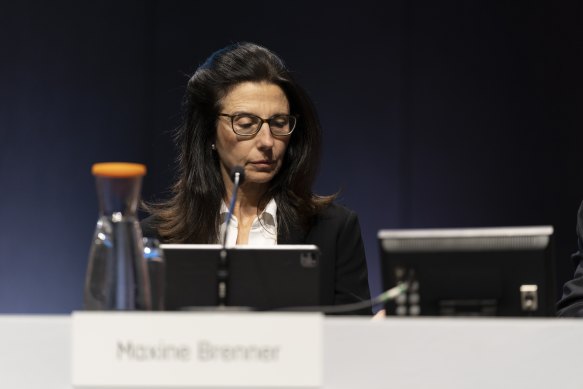Women ‘allowed into the tent’ with board seats, but men take top-paying chair roles
Women now hold almost 40 per cent of the board roles at Australia’s biggest companies, but men continue to dominate the highest-paid roles.
Governance advisory firm Ownership Matters has issued its annual analysis of ASX-listed companies, and it reveals the highest-paid directors. All but one of the top 15 are men.
“The men are allowing record numbers of female directors into the tent but are yet to meaningfully hand over the best paid chairing roles,” Ownership Matters director Dean Paatsch said.

Maxine Brenner was the only woman to make the top 15 highest-paid directors’ club in 2023, said Ownership Matters. Credit: Eamon Gallagher
Maxine Brenner was the 15th highest-paid director in 2023. She sits on the boards of Telstra, Woolworths and Origin Energy. In 2023, she also sat on the Qantas board and took home $1.2 million across the four positions, the report said.
The report found that the top 100 companies have at least two female directors. In 2023, 39.8 per cent of board positions at ASX 100 companies were held by women, up from 9.6 per cent in 2005. Macquarie Group, Woolworths and Nine Entertainment – the owner of this masthead – are the only companies that have more female directors than male.
Just 34 of the 286 companies surveyed have a female chair and only 21 have a female chief executive. But women lead some of the country’s biggest companies, with Qantas, Telstra, Coles and Transurban recently appointing a female chief executive for the first time.
The ASX director talent pool is slowly broadening too. For years, the same few women occupied several director roles. But the report found there are no longer any directors, male or female, sitting on five separate boards in the ASX 300, and none with four board positions in the top 100. There were 74 new directors who joined the top 100 companies last year, while 66 were appointed to the top 200.
“We expect over-boarding to abate through time,” Paatsch said. “It’s possible but difficult for people to maintain four roles or more, especially when there’s a crisis at one of those companies.
“Investors have no problem paying for non-executive director talent, but they resent paying full rates for partial attention.”
Paatsch said companies were increasingly focused on finding directors of differing ages, but there was not much attention paid to cultural diversity.
“I’m not aware of discussion around cultural backgrounds, but there is now a lot of focus on having age diversity in companies that are consumer- or tech-exposed. You don’t want to have a pale, male, stale 65-year-old advising a fast-moving consumer goods company which primarily serves young women,” he said.
There were still too many directors who did not own ordinary shares in the companies they governed, despite a 10 per cent improvement last year, Paatsch said.
Michael Harvey, son of Harvey Norman executive chair Gerry Harvey, has sat on the retail group’s board for 30 years and holds no shares.
But Harvey is now in the minority; 60 per cent of ASX 100 directors have holdings valued at more than one year’s worth of cash fees, up from 50 per cent in 2022.
“What is the excuse for sitting on a board and not being aligned through sacrificing part of your fees to experience the same as shareholders?” Paatsch said.
The Business Briefing newsletter delivers major stories, exclusive coverage and expert opinion. Sign up to get it every weekday morning.